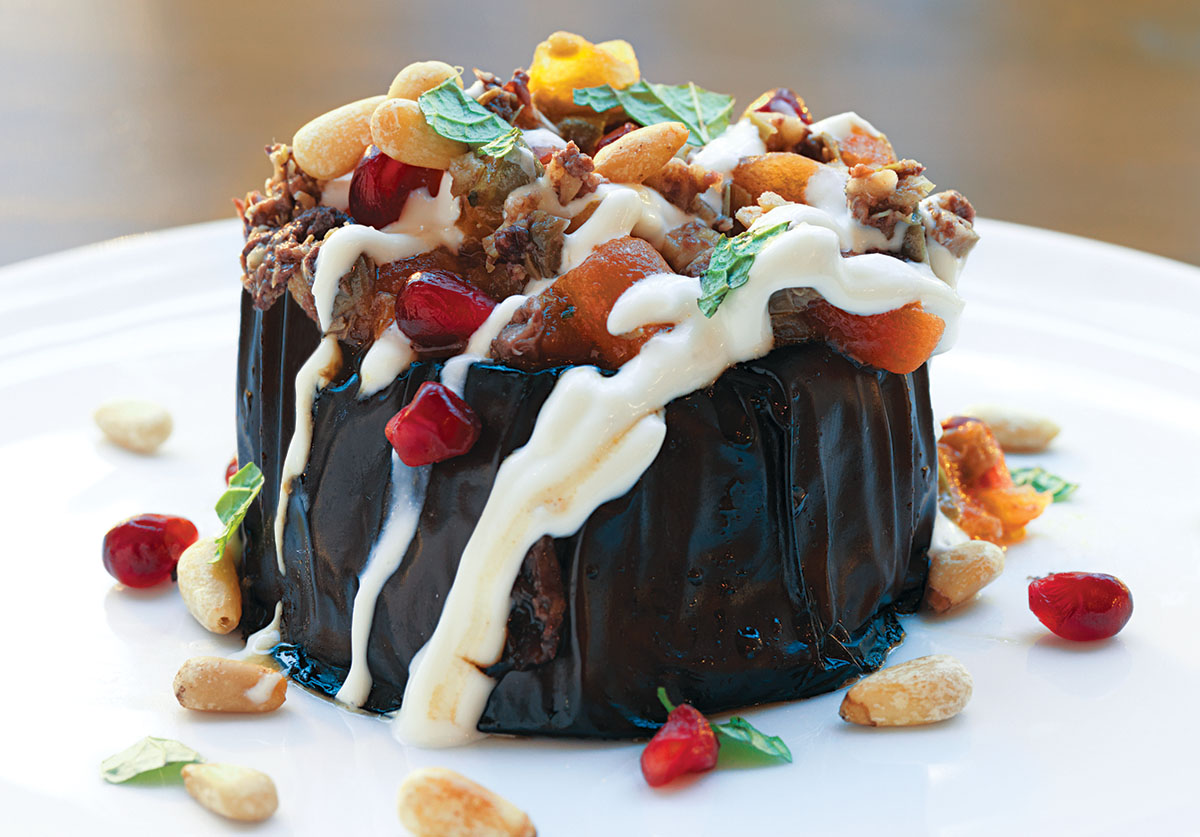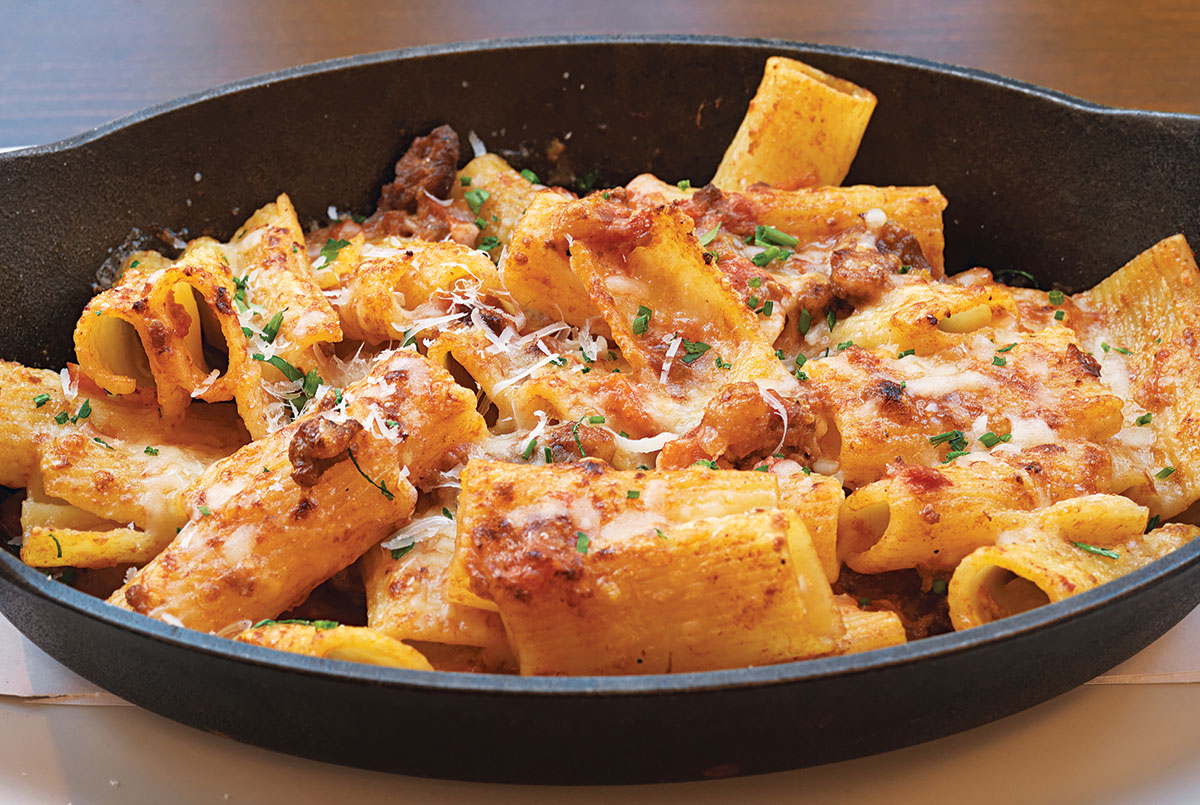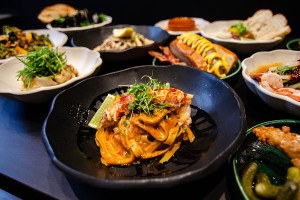Restaurant Review: Trade in Boston
Lamb sausage flatbread with eggplant, Manchego, peppers, and garlic yogurt, $15.
Trade is an improbable success. It’s a big urban brasserie in a funky, beautifully renovated old brick building opened by a high-profile chef and her ambitious young partners. Why improbable? Not because of the talent. Since opening Rialto nearly two decades ago, chef Jody Adams has made it into one of the most successful restaurants in Cambridge. She’s also written a book. Her partners, Sean Griffing and Eric Papachristos, may not have her exalted résumé, but they’ve both got Boston restaurant experience (Papachristos bought and revived Victoria’s Diner, and Griffing was Rialto’s general manager).
No, it’s improbable because Trade is located in a part of the Financial District that seems devoid of foot traffic, or any traffic at all in the evening. But Trade is a huge, happy hit nonetheless. That it does a brisk lunch business is no shock—it’s next to the Federal Reserve and South Station, and across the Greenway from dozens of office buildings. But I was surprised to see it so busy at all four of my dinners there. Each time there was a crowd at the big bar area, with its neat iron-and-wood industrial-era stools and reclaimed-pine tables and countertops, both of which afford a view of the pizza oven. Here, the dinner trade starts early.
The dining room, too, was packed — and noisy. (Window treatments, since added to the two-story windows, now help keep the sound in check.) The noise was the only thing keeping me from saying, “If you like Rialto, you’ll love Trade.” And even though I could barely hear myself or my guests, I confess that I actually like Trade better. As I sampled the menu, it seemed as if Adams and her longtime Rialto associate Andrew Hebert, who is Trade’s executive chef, kicked back, took stock of the cuisines and ingredients they’d always wanted to play with, and played. In fact, that’s exactly what Hebert says they did, and with a couple of exceptions, the results are pretty terrific.
Take the “flatbreads,” which are one of Trade’s signature offerings. (For the most part, they’re actually more like pizzas. The team here seems to want to take liberties with the menu categories.) I recommend ordering one, if only to try the dough. Hebert told me that he and Adams spent a few days in Seattle working with the maker of the Wood Stone gas oven they bought, learning to apply the manufacturer’s techniques to a dough recipe they’d developed. The resulting crust rivals Picco’s as one of my favorites in town. It’s at its best topped with just rosemary, ricotta salata, and sea salt ($11), though it’s also excellent when rolled thin like lavash, dusted with sesame seeds, and cut into crackers, which are served as the base for a great appetizer of seared chicken livers with radishes and kumquat ($9).
I found most of the other pizzas — er, flatbreads — needlessly heavy, including the four-cheese version with fresh tomatoes, basil, and arugula ($13), and the one topped with mushrooms, fig, Gorgonzola, sage pesto, and walnuts ($16). An exception was the lamb sausage version with eggplant, Manchego, peppers, and garlic yogurt ($15; shown at top). I’d eat that sausage and peppers on pretty much anything.
More ground lamb appears in the chili-flake-spiced ragu of rigatoni and provolone ($22). The dish is wonderfully browned in that oven, and so good you might scan the menu for more pastas. You won’t find any. Hebert says that he and Adams deliberately avoided loading the menu with pastas, so as not to look like they were doing the same thing they did at Rialto. It’s wise that they steer clear of handmade pasta — everybody does it, and it’s almost never as satisfying as what you get from a box, especially when it’s done like the rigatoni.
Whole roasted fish ($24) was similarly transformed in that charmed oven, and shone in its crisp-skinned, moist-fleshed simplicity. The smashed fingerlings beside it, spiced with coriander, cumin, and paprika, were oily, hot, and addictive; they’re also available as a side for $5, and would be great with drinks. The oven did wonders for red-wine-marinated short ribs ($27), as well, served on the bone in a cast-iron pot. It’s so nice to have ribs braised for three hours in an oven rather than cooked sous-vide, as is so common these days, since roasting yields a pleasant crust. Oranges and olives gave the ribs a Mediterranean flavor, and while the accompanying Jerusalem artichokes seemed bitsy and mealy for such a hearty dish, a daikon-ginger slaw freshened the plate. Plancha-seared chicken ($24) is spatchcocked (who can resist that word, which means boned except for the leg and winglet?), with herbs stuffed between the meat and marvelously charred skin. With seared orange sections, sweet dates, and quinoa cooked in a wine-and-saffron broth, it was an excellent dish. The one outright failure on the menu was a seafood stew ($25) in a ginger-lemongrass broth with coconut milk and vermicelli noodles — a wan, watery waste of good local shellfish.
Whether they’re listed as small plates or “a little extra,” a.k.a. sides, the vegetable dishes excel. Hebert irresistibly blackens baby Brussels sprouts, pairing them with a smoky romesco sauce made with sweet-hot Aleppo pepper and hazelnuts ($7). But nothing tops the pillowy, steak-cut roasted eggplant glazed with pomegranate molasses and topped with olive tapenade and garlic yogurt ($8; shown right). People often claim eggplant is a terrific substitute for meat, and here, finally, it is. I found myself lapping up the yogurt sauce. But what made the dish was the sweetness of the molasses, pomegranate seeds, and mint leaves combined with lots of salt from anchovies and capers. The thick, flat slice looks like an individual tart, and given the current vogue for mixing salt and sugar, it could even be a dessert.
That might be a better finale than the ones that were actually on the dessert menu when I was there. The Taza chocolate budino with sea salt, rosemary, and a hazelnut wafer ($9), for instance, featured a nicely salty wafer, but the thick-set pudding was just ordinary. A New England take on baked Alaska with pecans, maple sorbet, and cranberries ($9) was an oddly ascetic dessert; the meringue was disappointingly anemic, but the sorbet was as refreshing as snow. The Maine apple crostata ($8), however, took full advantage of the oven. I’d like to see more experimentation with baked tarts, given the kitchen’s success rate with flatbreads and oven-roasted entrées. But I have to admit: I’m looking for things to criticize. Provided I can hear myself think — and hear the people around me talk — I’ll be back to Trade, and often.
Chicken livers on sesame-seed crackers with radishes and kumquats, $9.
Pomegranate-glazed eggplant with capers, olives, and pine nuts, $8.
Baked rigatoni with spicy lamb ragu and provolone, $22.
Plus | Rosemary and ricotta salata flatbread, $11 | Whole roasted fish with cumin potatoes, $24 | Half chicken with burnt orange, dates, and pistachios, $24 | Braised short ribs with sunchokes, $27
Trade, 540 Atlantic Ave., Boston, 617-451-1234, trade-boston.com.
Critic Corby Kummer—an editor at the Atlantic and author of The Pleasures of Slow Food—has been reviewing Greater Boston’s top restaurants in our pages since 1997.






